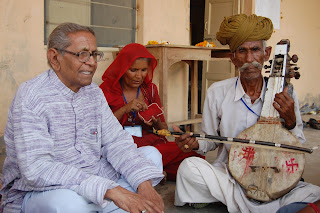 |
| Than of Pir Pithora at Adoori, Bikaner |
Largely because of it's location, the Thar Parkar
district has held an important place in the social and economic history of the
arid regions of Rajasthan and Gujarat. The history of settlement of this region
has made it a linguistic zone where several dialects like Marwari, Kutchi,
Dhati, Sindhi, Balochi, Pathani, and Punjabi were spoken. This polyglot character
of the region coupled with attributes of a frontier region has imparted the
region with a cultural diversity that has got disseminated to the adjoining
regions over successive historical periods.
The contribution of the region in the formation of the
folk culture of Marwar has been immense. Most of the popular folk songs which
are hummed and sung by the people of western Rajasthan like todadlo, heli,
moomal‑ mahendro, kachbo, balochan, raiko, jalal, hanjlo, ratan rano, ridmal,
sodo khiwro have the Dhat region as their landscape. The famous historical couplet
of ‘nav koti marwar’ mentions Omerkot,
the farthest fort on the eastern banks of Indus, as one of the nine forts that
mark the boundary of Marwar region. This
region has served as a refuge zone and a transitional region where the Rajputs
of Rajpootana interacted with muslims from Sind and Balochistan.
 |
| A Pak Ousteee in Command Area of IGNP Allotted to them |
Around nine thousand families from Chachro
taluka crossed over to villages of Chohtan and Sheo tehsils of Barmer in
Rajasthan. About five thousand families from Nagar parkar taluka escaped to the
neighboring region of Kutch and North Gujarat. These communities had fled for
the fear of persecution, hardship and discrimination at the hands of
the military dictatorship of the Islamic state of Pakistan as well as the
uncertainties and grain scarcity of the war affected occupied territory. They defied the orders of the Shimla Pact of 1972 that stipulated
repatriation of prisoners of war and civilian internees. The persuasions of the
Sindhi politicians to take them back to Pakistan proved abortive. Their hopes for a better
future in India eroded in the face of the growing hostility of the raiyas
(natives) on the Indian side of the border as well as by the partisan treatment
meted out by the Indian state. Viewed with suspicion they were doomed to
exist as sharanarthis (refugees) dependent upon the rations provided by
the Indian state in relief camps under confinement and strict surveillance.
Theses refugee camps continued for a little more than a decade and have left
indelible marks on the future life patterns of these communities. After the
granting of Indian Citizenship in 1977 the refugee camps were gradually closed
and by 1980 majority of these families were rehabilitated. In Gujarat around
five thousand families have been rehabilitated in villages and towns of Kutch
and north Gujarat. Some of the families have been given agricultural lands,
others plots for setting up small business and household livelihoods and many
were hardly given any assistance. In Rajasthan out of eight thousand families
to be rehabilitated around five thousand were allotted rain fed agricultural land
in Barmer and Jaisalmer district. And three thousand families were allotted
twenty five bighas land in what would qualify as one of the worst patches of
land in the canal command area of the IGNP Stage II in Bikaner in Rajasthan.
It is during extended sessions of listening to refugee
lore from many men and women from different castes that the rich multi layered
connections between these two regions gets revealed.
The
multi-layered cultural exchange that had developed historically was further
added on in years after the exodus. The gripping popular music of singers like
Mai Bhagi, Haider Rind, Fojia Soomro, Kasam Aadoo, Sawan Khan, especially it's
nostalgic and emotional rendering, make listening of experiences of this
community a memorable event. The recordings of live music sessions of these
singers, while invoking the memory of displacement and life in Thar Parkar reinforces
the strong cultural traditions of the Dhati community which gave them strength
to cope up with tough times in an uprooted context of survival. One such cultural strategy has been the recreation of shrine of Pir Pithora, a popular deity in Thar Parkar, in their new villages.
 |
| Bhagi ji and Jivraj singh soda (vani session at Adoori, Bikaner, April 2010) |
These
regions have had their own share of rich music traditions by Meghwals and Ravanna
Rajputs who using simple instruments- a tanpoora, mata and khanjari- create
reverberating music that serves as a bridge not only between the different scattered communities
but also provides soulful connections for remembrance of past.















